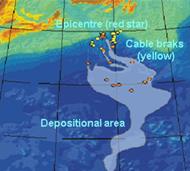How do turbidity currents work?
This short video shows a simple density flow demonstrated using a plastic aquarium and a slurry of builders’ plaster. It is easily reproduced in the laboratory.
Note: Builders’ plaster sets hard – best to clean up asap! Clay can be used but will cloud the water and obscure subsequent flows.
This demonstration illustrates two important geological processes: turbidity currents on the sea floor, and pyroclastic flows from volcanoes. Both processes rely on the fact that a mixture of solid particles (sediment or volcanic ash) and a fluid (water or volcanic gases) will form a flow capable of moving down slopes at high speeds.
Note: Builders’ plaster sets hard – best to clean up asap! Clay can be used but will cloud the water and obscure subsequent flows.
This demonstration illustrates two important geological processes: turbidity currents on the sea floor, and pyroclastic flows from volcanoes. Both processes rely on the fact that a mixture of solid particles (sediment or volcanic ash) and a fluid (water or volcanic gases) will form a flow capable of moving down slopes at high speeds.
 The generation of a turbidity current was first suggested to explain the breakage of twelve transatlantic telephone cables following an earthquake off the Grand Banks (Newfoundland) in 1929, although the evidence was reinterpreted until the 1950s. The seismic event appears to have destabilised soft sediment that began to move down the continental slope, mixing with water and forming a flow that travelled over 600 km out onto the ocean floor, attaining speed of up to 100 km/h as it did so.
The generation of a turbidity current was first suggested to explain the breakage of twelve transatlantic telephone cables following an earthquake off the Grand Banks (Newfoundland) in 1929, although the evidence was reinterpreted until the 1950s. The seismic event appears to have destabilised soft sediment that began to move down the continental slope, mixing with water and forming a flow that travelled over 600 km out onto the ocean floor, attaining speed of up to 100 km/h as it did so. We now know that these currents transport massive quantities of sediment to the deep ocean and form very characteristic “turbidite” (or Bouma) sediment sequences.

